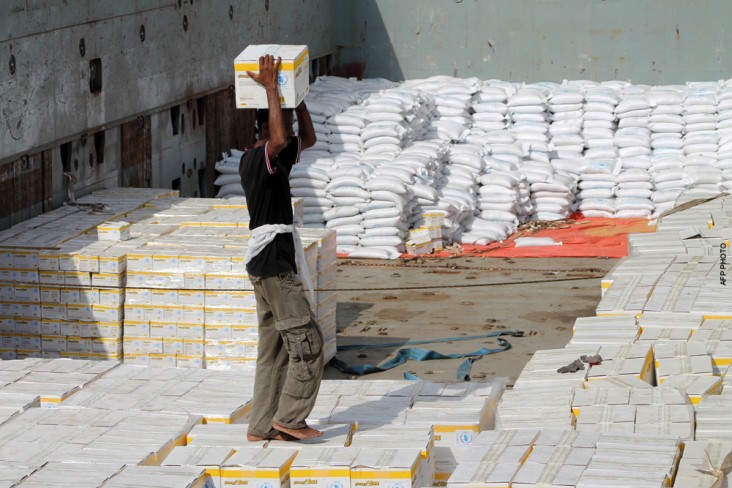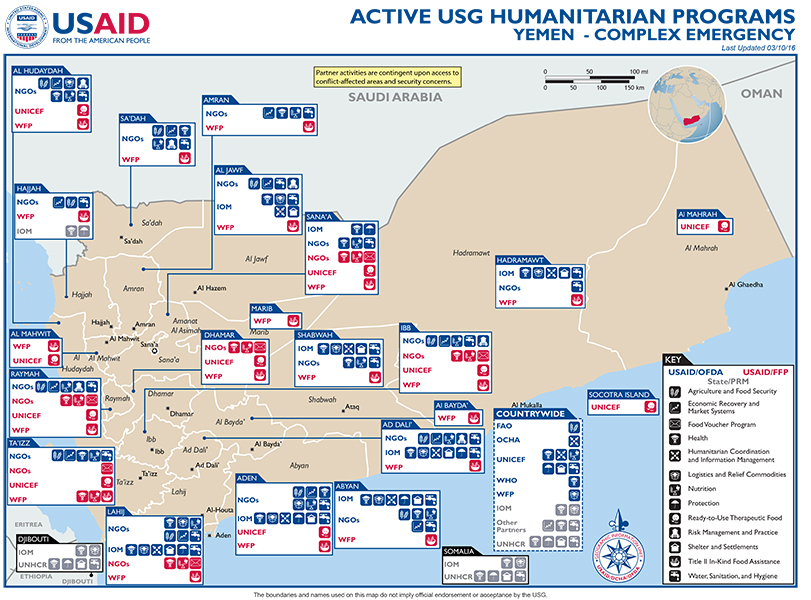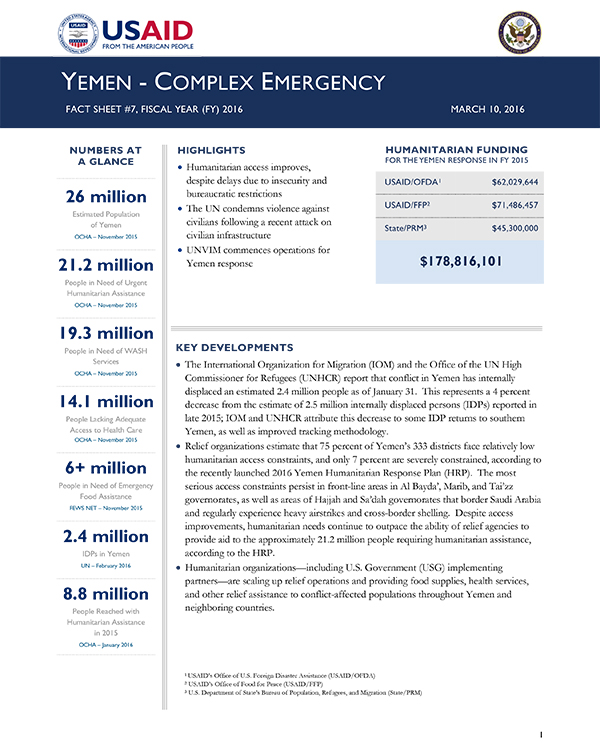- What We Do
- Agriculture and Food Security
- Democracy, Human Rights and Governance
- Economic Growth and Trade
- Education
- Ending Extreme Poverty
- Environment and Global Climate Change
- Gender Equality and Women's Empowerment
- Global Health
- Water and Sanitation
- Working in Crises and Conflict
- Disaster Assistance
- Political Transition Initiatives
- Conflict Mitigation and Prevention
- Countering Violent Extremism
- Disaster Risk Reduction
- Peacebuilding and Reconciliation
- Providing Safe & Secure Environments for Development
- Recovering From Crisis
- Resilience
- Tech Challenge for Atrocity Prevention
- World Humanitarian Day
- U.S. Global Development Lab
March 10, 2016
Highlights
Humanitarian access improves, despite delays due to insecurity and bureaucratic restrictions
The UN condemns violence against civilians following a recent attack on civilian infrastructure
UNVIM commences operations for Yemen response
Key Developments
Yemen Map - 03-10-2016 ![]() (pdf - 622k)
(pdf - 622k)
Numbers At A Glance
26 million
21.2 million
19.3 million
14.1 million
6+ million
2.4 million
8.8 million
Humanitarian Funding
For the Yemen Response in
FY 2015
| USAID/OFDA | $62,029,644 |
| USAID/FFP | $71,486,457 |
| State/PRM | $45,300,000 |
| TOTAL | $178,816,101 |
Yemen Complex Emergency Fact Sheet #7 - 03-10-2016 ![]() (pdf - 257k)
(pdf - 257k)
The International Organization for Migration (IOM) and the Office of the UN High Commissioner for Refugees (UNHCR) report that conflict in Yemen has internally displaced an estimated 2.4 million people as of January 31. This represents a 4 percent decrease from the estimate of 2.5 million internally displaced persons (IDPs) reported in late 2015; IOM and UNHCR attribute this decrease to some IDP returns to southern Yemen, as well as improved tracking methodology.
Relief organizations estimate that 75 percent of Yemen’s 333 districts face relatively low humanitarian access constraints, and only 7 percent are severely constrained, according to the recently launched 2016 Yemen Humanitarian Response Plan (HRP). The most serious access constraints persist in front-line areas in Al Bayda’, Marib, and Tai’zz governorates, as well as areas of Hajjah and Sa’dah governorates that border Saudi Arabia and regularly experience heavy airstrikes and cross-border shelling. Despite access improvements, humanitarian needs continue to outpace the ability of relief agencies to provide aid to the approximately 21.2 million people requiring humanitarian assistance, according to the HRP.
Humanitarian organizations—including U.S. Government (USG) implementing partners—are scaling up relief operations and providing food supplies, health services, and other relief assistance to conflict-affected populations throughout Yemen and neighboring countries.
FOOD SECURITY AND NUTRITION
In February, USAID/FFP partner the UN World Food Program (WFP) distributed emergency food assistance to more than 3.2 million people, surpassing the UN agency’s monthly target of 3 million people. In addition, WFP introduced a commodity-based voucher program to increase conflict-affected households’ access to food items—including cereals, pulses, vegetable oil, salt, sugar, and wheat soy blend—in several districts of Sana’a city. An estimated 98,700 people, or 85 percent of the targeted population, redeemed vouchers between February 14 and March 5. WFP plans to expand the program to additional governorates in the coming weeks as resources and market and security conditions allow.
The USAID-funded Famine Early Warning Systems Network (FEWS NET) recently reported that household purchasing power in Yemen remains severely limited despite a substantial decrease in wheat flour prices in late 2015. Lack of income and reduction in labor market activities as a result of the conflict are contributing to food insecurity across the country; households in some conflict-affected governorates continue to experience Emergency—IPC 4— levels of food insecurity.4
A USAID/OFDA partner is providing nutrition assistance to conflict-affected people in Abyan, Aden, Lahij, and Shabwah governorates. From February 15–29, the NGO treated nearly 90 children for severe acute malnutrition and more than 150 children for moderate acute malnutrition, including through the provision of ready-to-use therapeutic foods, in Aden, Abyan, and Shabwah. Additionally, community volunteers trained by the NGO reached more than 1,300 women with health education campaigns, which included information about optimal infant and young child feeding practices to support community-based management of acute malnutrition.
LOGISTICS SUPPORT AND RELIEF COMMODITIES
As of early March, the UN Verification and Inspection Mechanism (UNVIM) for Yemen had commenced operations, soliciting requests for the monitoring of maritime traffic and clearing of shipments destined for Yemeni ports. In accordance with UNSC Resolution 2216, the mechanism intends to verify and inspect shipments, including commercial goods purchased by Yemen-based entities intended for sale in country and bilateral assistance from UN member states, which pass through Yemeni ports not under Republic of Yemen Government (RoYG) control, according to the UN. The UNVIM—which aims to expedite legitimate commercial imports of fuel, food, medication, and other essential commodities—was established following a mid-2015 request by the RoYG.
The UN Humanitarian Air Service (UNHAS) has expanded operations in Yemen in response to increasing needs, according to WFP. In early March, UNHAS announced the launch of a new service route, twice-weekly flights between Jordan’s capital city of Amman and Djibouti via Sana’a city, to supplement humanitarian transportation needs in the absence of consistent commercial air operations in Yemen. Since April 2015, UNHAS has transported humanitarian workers between Djibouti and Yemen and airlifted nearly 25,000 pounds of cargo, including essential medical supplies, supporting 45 relief organizations providing life-saving assistance to conflict-affected Yemenis.
From February 4–17, USG partner IOM distributed 300 emergency relief item kits, composed of blankets, kitchen sets, mattresses, plastic sheets, and water containers, to an estimated 2,100 IDPs in a largely inaccessible enclave— comprising Al Qahira, Mudhafa, and Salah districts—in the city of Ta’izz. Since the beginning of the crisis, IOM has reached more than 47,500 IDPs throughout Yemen with shelter support and emergency relief commodities.
HEALTH
Preliminary reports from USAID partner the UN Children’s Fund (UNICEF) indicate that a UNICEF-sponsored polio, measles, and rubella vaccination campaign, which began on January 9, had reached more than 487,000 children across all hard-to-reach areas of Ta’izz Governorate as of February 9. Between January 27 and February 9, UNICEF also distributed medication and maternal and child health supplies to state-operated health facilities in Amran, Al Bayda’, Dhamar, Ibb, Ta’izz, and Sana’a governorates, with support from 75 mobile teams. During the same reporting period, UNICEF also provided integrated health services across 17 governorates, reaching more than 30,000 people.
A USAID/OFDA partner provided health consultations to more than 5,400 people and immunizations for nearly 500 children across Abyan, Aden, Lahij, and Shabwah governorates from February 15–29. During the same period, the NGO offered prenatal and other reproductive health services to more than 400 pregnant women. Community health volunteers trained by the NGO also reached more than 1,300 women with health education messages regarding infectious diseases, as well as the importance of prenatal and postnatal care and immunizations.
From February 4–17, IOM provided health assistance—including emergency, primary, and reproductive care, as well as mental health and psychosocial support—to nearly 105,000 IDPs across nine governorates.
WASH

UNICEF continues to provide water, sanitation, and hygiene (WASH) assistance to conflict-affected populations of Amanat al ‘Asimah, Amran, Hajjah, Lahij, Sa’dah, and Ta’izz governorates. Between January 27 and February 9, UNICEF supported local water systems to ensure access to safe drinking water for approximately 1.3 million people across five of the six governorates. In Hajjah and Sa’dah, UNICEF also distributed more than 6,200 hygiene kits—benefitting nearly 40,000 conflict-affected people—and reached more than 61,800 people with hygiene promotion campaigns, focusing on hand washing, personal hygiene practices, and safe water storage.
Despite access constraints due to ground fighting, airstrikes, and fuel scarcity, a USAID/OFDA partner continues to meet the immediate WASH needs of conflict-affected Yemenis, including in Ibb Governorate where the NGO has distributed hygiene kits to more than 14,000 people and supported the local water company to sustain water pumping for nearly 300,000 people. The partner has also promoted improved sanitation for nearly 60,000 people in rural areas of Ad Dali’ Governorate, rehabilitated nearly 20 communal water points, and distributed water filters to households across 15 villages in the governorate.
In Abyan, Aden, and Lahij governorates, a USAID/OFDA partner is facilitating a WASH-focused livelihoods project, coordinating with health centers, schools, and community members to promote hygiene awareness, distribute hygiene kits, test water supplies, and manage water tanks and other WASH infrastructure. From February 1–13, the partner delivered an estimated 4.2 million liters of safe drinking water to distribution points across the three governorates, distributed hygiene kits to 500 households in Abyan, and reached an estimated 13,200 people in Abyan and Lahij with sanitation and hygiene messages.
Through USAID/OFDA support, another NGO distributed hygiene kits to 1,500 families in Aden from February 15–29, with additional distributions planned for the coming weeks. The partner continued daily emergency water trucking to increase access to safe drinking water for approximately 11,200 conflict-affected people in Abyan. The NGO is also supporting the WASH needs of IDPs in Shabwah through the construction of five new latrines, the installation of hand-washing stations, and the rehabilitation of five health facilities.
OTHER HUMANITARIAN ASSISTANCE
UN Resident and Humanitarian Coordinator (RC/HC) for Yemen Jamie McGoldrick cautioned the international community against failing to meet the funding requirements of the 2016 Yemen HRP—totaling more than $1.8 billion—at a March 1 press conference in Amman. RC/HC McGoldrick noted that approximately 75 percent of the appeal directly supports critical, life-saving interventions for vulnerable populations. As of March 10, the 2016 Yemen HRP had received $60.8 million, representing 3 percent of the appeal.
In late February, the KSA’s King Salman Humanitarian Aid and Relief Center (KSRelief) committed to support four private health facilities providing medical services to conflict-affected populations in Yemen, distributed food commodities and tents in Al Jawf Governorate, and conducted three airdrops of food supplies in Ta’izz city—in coordination with relief organizations on the ground. KSRelief also plans to build 300 shelter units, as well as educational, health care, and other communal facilities, benefitting more than 2,000 Yemeni refugees facing harsh weather conditions in Djibouti. KSRelief has provided food supplies, safe drinking water, medical services, and other emergency relief assistance to address the basic needs of vulnerable populations in Yemen and refugees in Djibouti. In addition, KSRelief is bolstering health care services in Yemen through support for the International Committee of the Red Cross, UNICEF, and the UN World Health Organization (WHO).
From February 22–24, representatives from more than 90 international and regional relief organizations convened in Qatar’s capital city of Doha for a conference organized by the Qatar Charity Society to address the humanitarian response in Yemen. On February 24, participant organizations announced funding contributions totaling more than $220 million to support humanitarian response efforts in Yemen over a three-year period. Pledges included $100 million each from the Qatar Charity Society and the Kuwait-based International Islamic Charitable Organization and $10 million from the Qatari Red Crescent Society, among other donations. Additionally, the conference resulted in the formation of a Gulf Cooperation Council (GCC) committee—led by KSRelief—to coordinate GCC assistance for the Yemen crisis. KSRelief expects the committee to gradually commence activities in the coming weeks.
CONTEXT
Between 2004 and early 2015, conflict between the RoYG and Al Houthi opposition forces in the north and between Al Qaeda-affiliated groups and RoYG forces in the south had affected more than 1 million people and repeatedly displaced populations in northern Yemen, resulting in humanitarian needs. Fighting between RoYG military forces and tribal and militant groups since 2011 limited the capacity of the RoYG to provide basic services, and humanitarian needs increased among impoverished populations. The expansion of Al Houthi forces in 2014 and 2015 resulted in the renewal and escalation of conflict and displacement, further exacerbating already deteriorated humanitarian conditions.
In late March 2015, a KSA-led coalition began airstrikes on Al Houthi and allied forces to halt their southward expansion. The ongoing conflict has damaged public infrastructure, interrupted essential services, displaced many people, and reduced the level of commercial imports to a fraction of the levels required to sustain the Yemeni population. The country relies on imports for 90 percent of its grain and other food sources.
The escalated conflict, coupled with protracted political instability, the resulting economic crisis, rising fuel and food prices, and high unemployment, has left nearly half of Yemen’s 26 million people food insecure and 6 million people in need of emergency food assistance.
In early 2015, Yemen hosted approximately 248,000 refugees and a substantial population of third-country nationals (TCNs). The escalation in hostilities has internally displaced an estimated 2.5 million people in Yemen and prompted IOM to organize large-scale TCN evacuations from Yemen. The volatility of the current situation prevents relief agencies from obtaining accurate, comprehensive demographic information.
On October 12, 2015, U.S. Ambassador Matthew H. Tueller reissued a disaster declaration for Yemen for FY 2016 due to continued humanitarian needs resulting from the complex emergency and the impact of the country’s political and economic crises on vulnerable populations.
PUBLIC DONATION INFORMATION
The most effective way people can assist relief efforts is by making cash contributions to humanitarian organizations that are conducting relief operations. A list of humanitarian organizations that are accepting cash donations for disaster responses around the world can be found at www.interaction.org.
USAID encourages cash donations because they allow aid professionals to procure the exact items needed (often in the affected region); reduce the burden on scarce resources (such as transportation routes, staff time, and warehouse space); can be transferred very quickly and without transportation costs; support the economy of the disaster-stricken region; and ensure culturally, dietary, and environmentally appropriate assistance.
More information can be found at:
- USAID Center for International Disaster Information: www.cidi.org or +1.202.821.1999.
- Information on relief activities of the humanitarian community can be found at www.reliefweb.int.









Comment
Make a general inquiry or suggest an improvement.